Research on the Reinforcement Effect and Bearing Characteristics of High-Pressure Jet-Grouting Piles on Covered Road Composite Ground in Landfill Sites
Abstract
1. Introduction
2. Engineering Overview
3. Experimental Study on the Technical Parameters of High-Pressure Jet-Grouting Piles in Landfill Sites
3.1. Adaptability Analysis of High-Pressure Jet-Grouting Piles
- (1)
- The construction waste-based miscellaneous fill is deeply buried, and the hard-impurity particles are uneven. The aggregate strength of concrete blocks, bricks, and other aggregates is high, but there is a large gap between the aggregates. If only mechanical compaction is performed, with the passage of time and rainwater infiltration, the foundation will be prone to uneven settlement, which will seriously hinder its later use.
- (2)
- If the strong compaction method is adopted, the hard impurities will damage the HDPE geomembrane placed under the garbage pile due to strong pressure, resulting in tearing of a large area of the impermeable membrane and the leakage of landfill gas and leachate into the garbage dump, affecting its overall stability; moreover, this would pose considerable safety risks and environmental pollution hazards.
- (3)
- High-pressure jet-grouting piles are used for foundation reinforcement, using drilling to crush strong aggregates, such as concrete blocks and bricks, and fully mix them with high-pressure cement slurry to form a high-strength columnar body, which plays a role in reinforcing the foundation. For some sections of a construction waste pile stratum with large voids, an appropriate amount of quick-setting agent is mixed into the slurry or the amount of grouting is increased to ensure that the pile is formed.
3.2. Design Estimation Parameters
3.3. Experimental Design of Pile Reinforcement
3.4. Actual Pile Test Parameters
3.5. Test Excavation and Coring Inspection
3.5.1. Test Excavation Inspection
3.5.2. Test Coring Inspection
3.6. Bearing Capacity Test
3.7. Analysis of Test Results
- (1)
- After the first round of excavation pile diameter detection, the pile diameter of all the test piles (1, 2, 3, 10, 11, 12) in the first group is 0.50 m~0.59 m, which is smaller than the diameter of the designed test pile of 0.60 m and does not meet the requirements; additionally, its cement content is 248 kg/m~266 kg/m, which does not meet the design requirements. The second (4, 5, 6, 13, 14, 15) and third groups of test piles (7, 8, 9, 16, 17, 18) have diameters of 0.60 m~0.69 m and cement contents of 274 kg/m~314 kg/m which do meet the pile diameter requirements.
- (2)
- The coring test results show that the core samples of the second group (4 and 13) of test piles are more broken (the cement content is 282 kg/m and 279 kg/m, respectively) and do not meet the design requirements; therefore, the jet-grouting effect of cement content of 282 kg/m and below (piles 5, 6, 14, and 15) cannot meet the design requirements, as shown in Table 3.
- (3)
- According to the static load test of the bearing capacity of the single-pile composite foundation of the No. 8 and No. 17 test piles, as shown in Figure 5, the load–settlement curve is slowly deformed, the ultimate load and the proportion limit are not obvious, and the characteristic value of the bearing capacity of the single-pile composite foundation can be determined according to the relative deformation value. Assume a pressure value corresponding to s/b = 0.008 (where s is the settlement of the bearing plate in the static load test, and b is the side length of the bearing plate); in this test, b is 1.0 m, namely, the load value corresponding to s = 0.008 × b = 8.0 mm is the characteristic value of the bearing capacity of the single-pile composite foundation. The characteristic value of the bearing capacity of the single-pile composite foundation obtained in the field test is 182.85 kPa~196.89 kPa, and the characteristic value of the bearing capacity of the foundation, determined using the relative deformation value, should not be greater than half of the maximum load of 350 kPa, and the smaller value is taken. Therefore, the characteristic value of the bearing capacity of the No. 8 and No. 17 monopile composite foundations is 175 kPa, which meets the design requirements. The rotary grouting effect of a minimum cement content of 298 kg/m and above, corresponding to the No. 8 and No. 17 piles, also meets the design requirements.
- (4)
- The static load test results for the composite foundation are summarized in Table 4. It can be seen that the No. 17 pile has a stronger bearing capacity than the No. 8 pile; this is because the No. 17 pile was tested according to the smaller distance between the piles, and the smaller the pile spacing at the same depth as the foundation soil layer, the more likely it is that the lateral displacement and deformation of the soil between the piles will cancel each other, thereby reducing the overall settlement and deformation of the foundation. Therefore, the settlement of the No. 17 pile is less than that of No. 8.
- (5)
- Comprehensively considering the on-site pile test construction scenario, test pile test results, economic applicability, and other factors, the following construction standard parameters can be used to guide the construction of high-pressure jet-grouting piles in landfill heaps, and better construction results can be obtained. The specific parameters are shown in Table 5.
4. Numerical Simulation of Bearing Capacity of Single-Pile Composite Foundation
4.1. Numerical Simulation Establishment and Parameter Selection
4.2. Numerical Simulation Results and Analysis
5. The Construction Process of High-Pressure Jet-Grouting Piles in Landfills
5.1. Construction Process
5.2. Construction Process Control
5.3. Problems Encountered in the Construction Process and Measures to Mitigate Them
- (1)
- There are large voids in some sections of construction waste heaps. If there is no slurry in the drilling process, an appropriate amount of quick-setting agent can be added to the slurry; as a result, the consolidation time is shortened, and the grout is solidified within a certain range.
- (2)
- A large amount of slurry in the drilling process is caused by incompatibility between the effective spraying range and the amount of grouting. Measures such as increasing the injection pressure, appropriately reducing the nozzle diameter, and speeding up the lifting and rotary spraying speed can be taken to reduce the amount of slurry.
- (3)
- Due to the solidification process of mixing grout with the miscellaneous fill, slurry water precipitation will occur, and there will be different degrees of pile shrinkage, resulting in depression during consolidation (this depression is usually between 0.3 m and 1 m at the top of the pile), and the depth varies with the soil quality, slurry precipitation, solid diameter, and other factors.
6. Conclusions
- (1)
- Regarding the thickness of the foundation soil layers composed of miscellaneous fill mainly from the building garbage pile, its composition is complex, and its treatment is difficult. A high-pressure jet-grouting pile composite foundation is used to reinforce the foundation soil, and the construction technology is simple, the reinforcement effect is remarkable, and a considerable amount of cement mortar is saved.
- (2)
- The test results show that the cement content has a significant impact on the bearing capacity of the single-pile composite foundation, and through the testing of the bearing capacity of the single pile and the composite foundation, the construction index of cement content greater than 300 kg/m is found to meet the design requirements. Through the comparison of different cement content results, a suitable cement dosage is found that can save costs to a certain extent and meet the needs of economic applicability. In the process of spraying the rotary grouting pile, the spraying pressure can be strictly controlled, and the spraying liquid can be evenly sprayed into the soil and fully mixed with the crushed soil to form a consolidated cement body to ensure the quality of the pile.
- (3)
- The characteristic value of the bearing capacity of the single-pile composite foundation obtained from the field test lies between 182.58 kPa and 196.89 kPa. The characteristic value of the bearing capacity of the numerical simulation of the single-pile composite foundation obtained through the ABAQUS numerical simulation is 186.01 kPa, which is slightly smaller than the value obtained in the field test, but the difference is small. Therefore, when field test conditions are not available, the characteristic value of the bearing capacity of the composite foundation can be used as a construction reference.
- (4)
- In the simulation of adding jet-grouting piles one by one around the high-pressure jet-grouting piles of a single pile, it is shown that with an increase in the number of jet-grouting piles in the actual project, the overall bearing capacity of the foundation will be stronger than that obtained in the simulation of a single pile, and the subgrade reinforcement effect will be better.
Author Contributions
Funding
Data Availability Statement
Conflicts of Interest
References
- Gao, S.; Meng, L.; Ge, X.; Li, Y.; Yang, Y.; Duan, Y.; Fu, Q.; Zhang, S.; Yang, X.; Fei, W.; et al. Role of garbage classification in air pollution improvement of a municipal solid waste disposal base. J. Clean. Prod. 2023, 423, 138737. [Google Scholar] [CrossRef]
- Liu, L.; Ji, H.; Lv, X.; Wang, T.; Zhi, S.; Pei, F.; Quan, D. Mitigation of greenhouse gases released from mining activities: A review. Int. J. Miner. Metall. Mater. 2021, 28, 513–521. [Google Scholar] [CrossRef]
- Dong, J.; Zhao, Y.; Zhang, W.; Hong, M. Laboratory study on sequenced permeable reactive barrier remediation for landfill leachate-contaminated groundwater. J. Hazard. Mater. 2009, 161, 224–230. [Google Scholar] [CrossRef] [PubMed]
- Jewaskiewitz, S.M. The rehabilitation of the New England Road landfill in Pietermaritzburg—A case study. Civ. Eng. 1995, 1995, 21–25. [Google Scholar]
- Yamawaki, A.; Doi, Y.; Omine, K. Slope stability and bearing capacity of landfills and simple on-site test methods. Waste Manag. Res. 2017, 35, 730–738. [Google Scholar] [CrossRef] [PubMed]
- Holzlöhner, U.; Meggyes, T.; Seeger, S. Landfill technology in Germany. Land Contam. Reclam. 1999, 7, 109–119. [Google Scholar]
- Rong, L.; Zhang, C.; Jin, D.; Dai, Z. Assessment of the potential utilization of municipal solid waste from a closed irregular landfill. J. Clean. Prod. 2017, 142, 413–419. [Google Scholar] [CrossRef]
- Zhao, C.; Zhao, D. Application of construction waste in the reinforcement of soft soil foundation in coastal cities. Environ. Technol. Innov. 2021, 21, 101195. [Google Scholar] [CrossRef]
- Liu, L.; Zhang, Z.; Wang, T.; Zhi, S.; Wang, J. Evolution characteristics of fracture volume and acoustic emission entropy of monzogranite under cyclic loading. Geomech. Geophys. Geo-Energy Geo-Resour. 2024, 10, 16. [Google Scholar] [CrossRef]
- Krook, J.; Svensson, N.; Eklund, M. Landfill mining: A critical review of two decades of research. Waste Manag. 2012, 32, 513–520. [Google Scholar] [CrossRef]
- Fan, H.; Xu, Q.; Lai, J.; Liu, T.; Zhu, Z.; Zhu, Y.; Gao, X. Stability of the loess tunnel foundation reinforced by jet grouting piles and the influence of reinforcement parameters. Transp. Geotech. 2023, 40, 100965. [Google Scholar] [CrossRef]
- Nguyen, X.L.; Wu, L.; Nguyen, K.T.; Bui, Q.A. Application research of high pressure jet grouting pile in an underground engineering in Vietnam. Arch. Civ. Eng. 2020, 66, 575–593. [Google Scholar] [CrossRef]
- Li, P.; Huang, X.; Lu, F.; Qiu, W.; Liu, H.; Li, L.; Wang, Y.; Chen, Z.; He, Z. Experimental investigation on the reinforcement of a high-pressure jet grouting pile for an ultra-shallow tunnel in a strongly weathered stratum. Front. Earth Sci. 2023, 10, 1040461. [Google Scholar] [CrossRef]
- Wei, J.Y.; Wang, B.T.; Zhang, J.H.; Zhou, B. Application of High Pressure Jet Grouting Pile with Undrained Open Caisson Combined Construction Technology in the Protection of Yangtze River Levee. Appl. Mech. Mater. 2013, 368, 1443–1449. [Google Scholar] [CrossRef]
- Ho, C.E.; Lim, C.H.; Tan, C.G. Jet grouting applications for large-scale basement construction in soft clay. In Innovations in Grouting and Soil Improvement; ASCE: Reston, VA, USA, 2005; pp. 1–15. [Google Scholar]
- Qiu, J.; Liu, H.; Lai, J.; Lai, H.; Chen, J.; Wang, K. Investigating the long-term settlement of a tunnel built over improved loessial foundation soil using jet grouting technique. J. Perform. Constr. Facil. 2018, 32, 04018066. [Google Scholar] [CrossRef]
- Li, Y.; Xu, S.; Liu, H.; Ma, E.; Wang, L. Displacement and stress characteristics of tunnel foundation in collapsible loess ground reinforced by jet grouting columns. Adv. Civ. Eng. 2018, 2018, 2352174. [Google Scholar] [CrossRef]
- Li, Z.; Zhao, J.; Hu, K.; Li, Y.; Liu, L. Adaptability Evaluation of Rotary Jet Grouting Pile Composite Foundation for Shallow Buried Collapsible Loess Tunnel. Appl. Sci. 2023, 13, 1570. [Google Scholar] [CrossRef]
- Dong, L. Numerical model for the settlement of loess subgrade in operation period reinforced by rotary jet grouting pile. Vibroeng. Procedia 2022, 41, 48–53. [Google Scholar] [CrossRef]
- Zhang, Y.; Qi, H.; Li, C.; Zhou, J. Enhancing safety, sustainability, and economics in mining through innovative pillar design: A state-of-the-art review. J. Saf. Sustain. 2023; in press. [Google Scholar] [CrossRef]
- Yuan, C.; Xie, Y.; Ou, M. Adaptive Optimization Method for Piled Raft Foundations Based on Variable Pile Spacing. Appl. Sci. 2023, 13, 1648. [Google Scholar] [CrossRef]
- Soga, K.; Alonso, E.; Yerro, A.; Kumar, K.; Bandara, S. Trends in large-deformation analysis of landslide mass movements with particular emphasis on the material point method. Géotechnique 2016, 66, 248–273. [Google Scholar] [CrossRef]
- Conte, E.; Pugliese, L.; Troncone, A.; Vena, M. A simple approach for evaluating the bearing capacity of piles subjected to inclined loads. Int. J. Geomech. 2021, 21, 04021224. [Google Scholar] [CrossRef]
- Yu, J.L.; Zhou, J.J.; Gong, X.N.; Xu, R.Q.; Li, J.Y.; Xu, S.D. Centrifuge study on behavior of rigid pile composite foundation under embankment in soft soil. Acta Geotech. 2021, 16, 1909–1921. [Google Scholar] [CrossRef]
- Wang, T.; Ye, W.; Liu, L. Study on the Mechanical Properties and Acoustic Emission Signal Characteristics of Freezing Pipe. Front. Earth Sci. 2023, 11, 1298025. [Google Scholar] [CrossRef]
- Liang, H.; Shi, L.; Wang, D.; Xiao, X.; Deng, K. Influence of graded coarse aggregate content and specific surface area on the fracture properties of asphalt mixtures based on discrete element simulations and indoor tests. Constr. Build. Mater. 2021, 299, 123942. [Google Scholar] [CrossRef]
- Zhu, D.L.; Wang, W.J.; Xie, X.Y.; Zheng, L.W. Reinforcement case of high-pressure rotary jet grouting pile for thick construction waste miscellaneous fill foundation. Build. Struct. 2020, 50, 116–120. [Google Scholar]
- Kavvadas, M.; Amorosi, A. A constitutive model for structured soils. Géotechnique 2000, 50, 263–273. [Google Scholar] [CrossRef]
- Savvides, A.A.; Papadrakakis, M. A computational study on the uncertainty quantification of failure of clays with a modified Cam-Clay yield criterion. SN Appl. Sci. 2021, 3, 659. [Google Scholar] [CrossRef]
- Troncone, A.; Pugliese, L.; Parise, A.; Conte, E. A simple method to reduce mesh dependency in modelling landslides involving brittle soils. Géotech. Lett. 2022, 12, 167–173. [Google Scholar] [CrossRef]
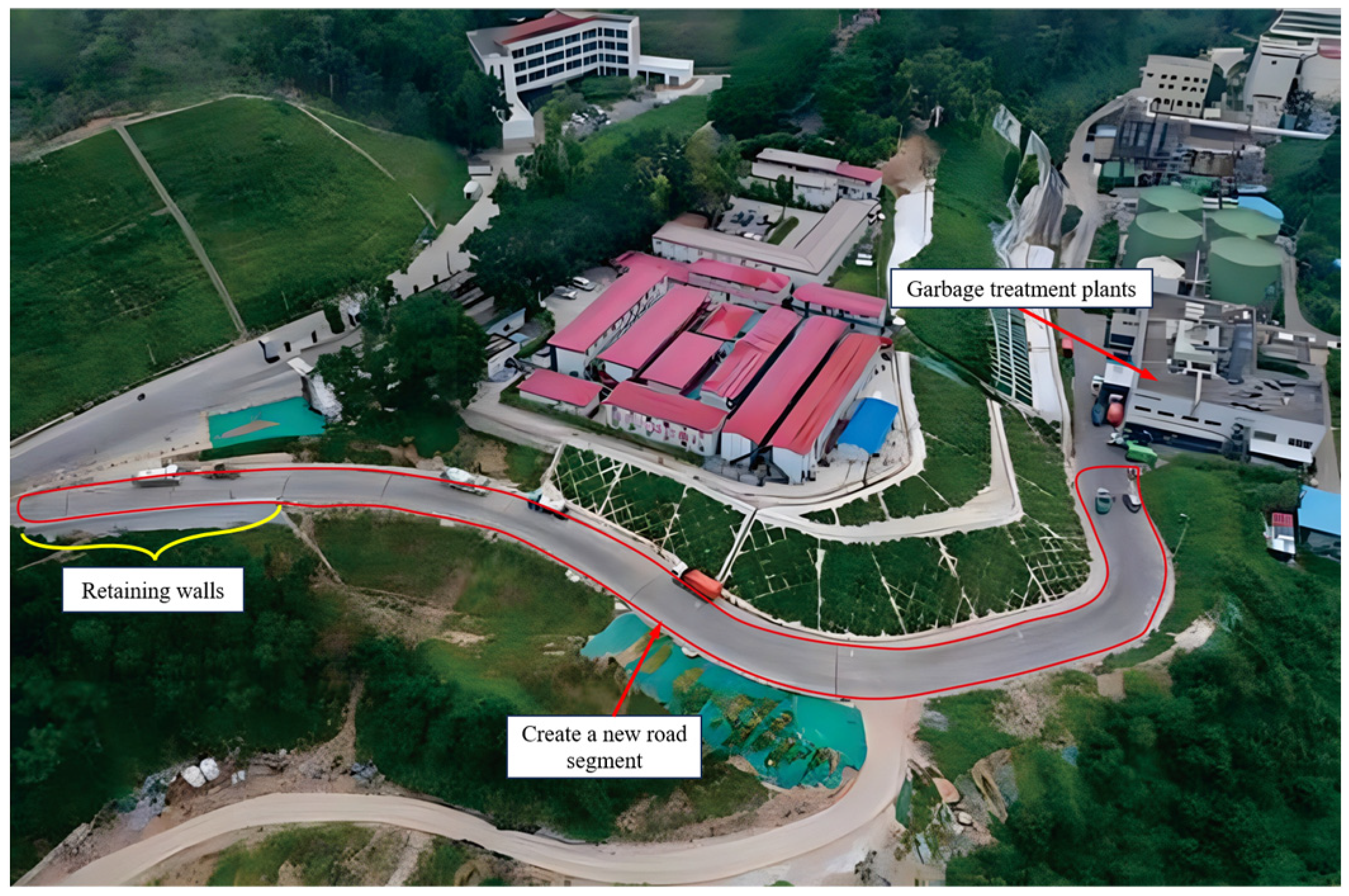
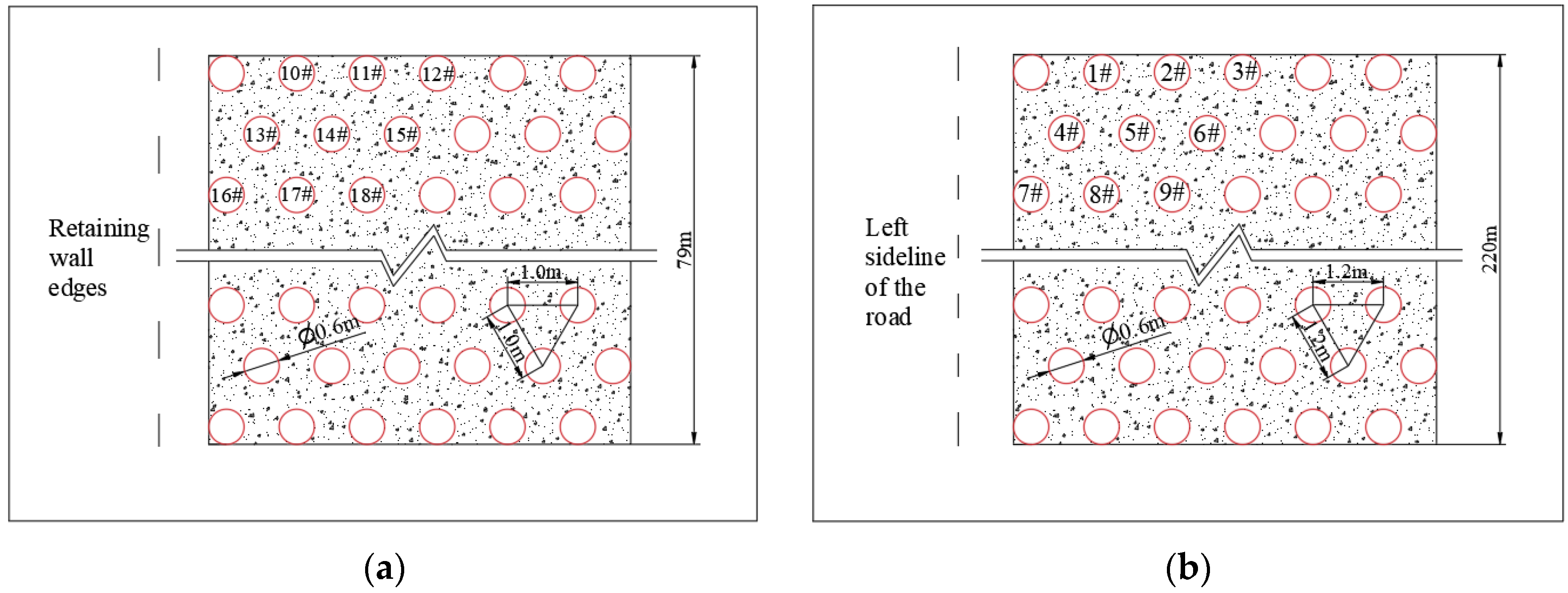
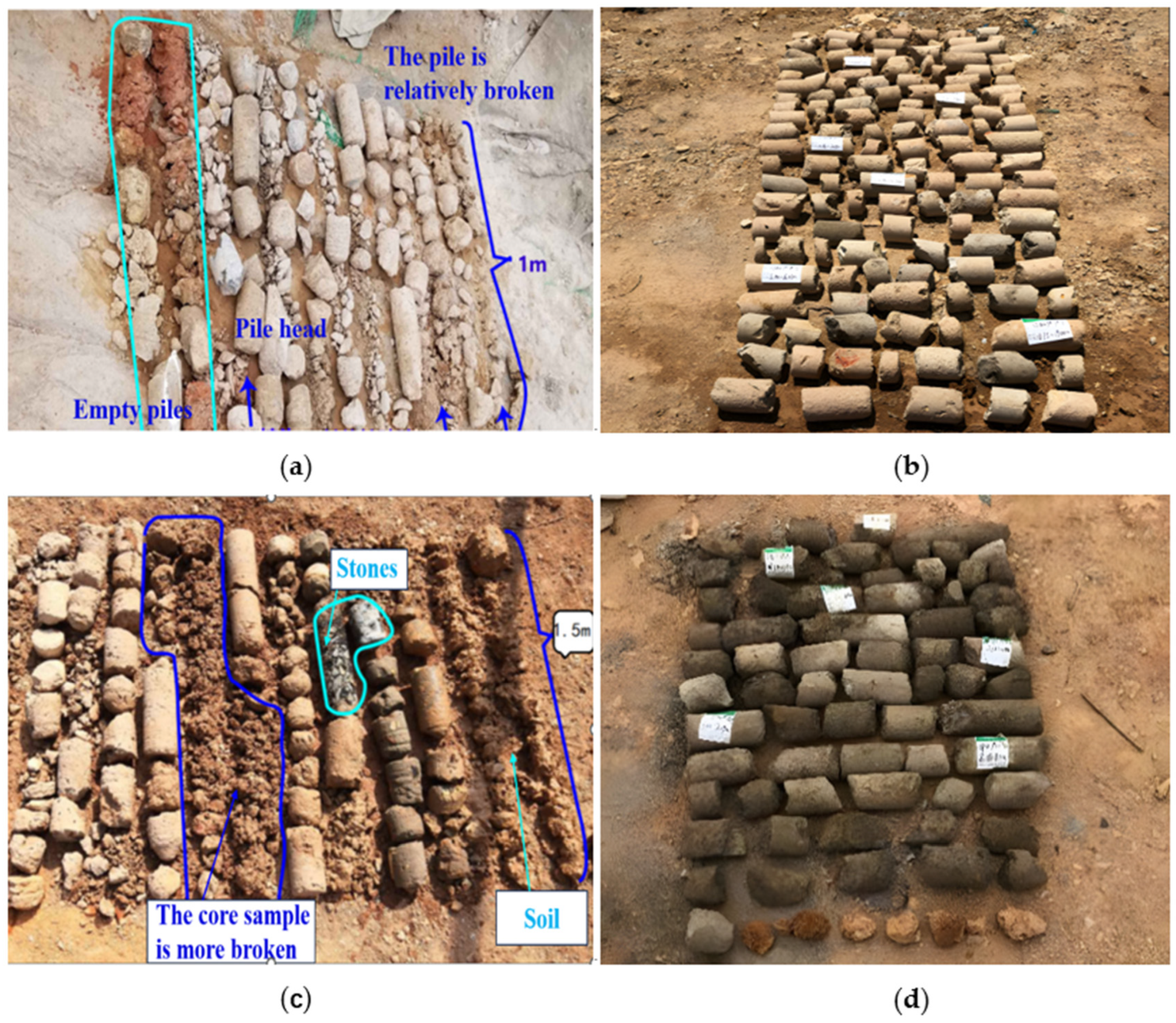

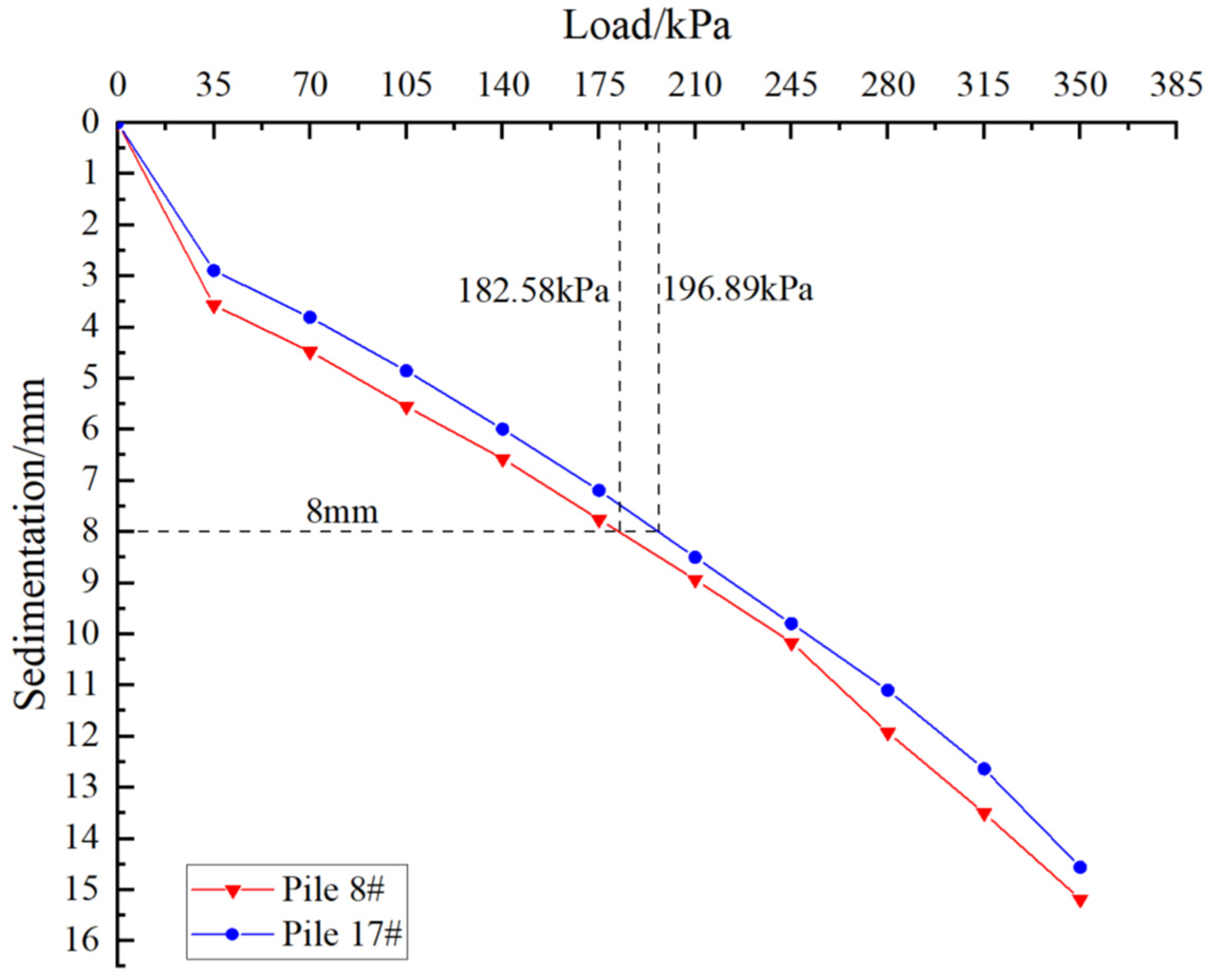
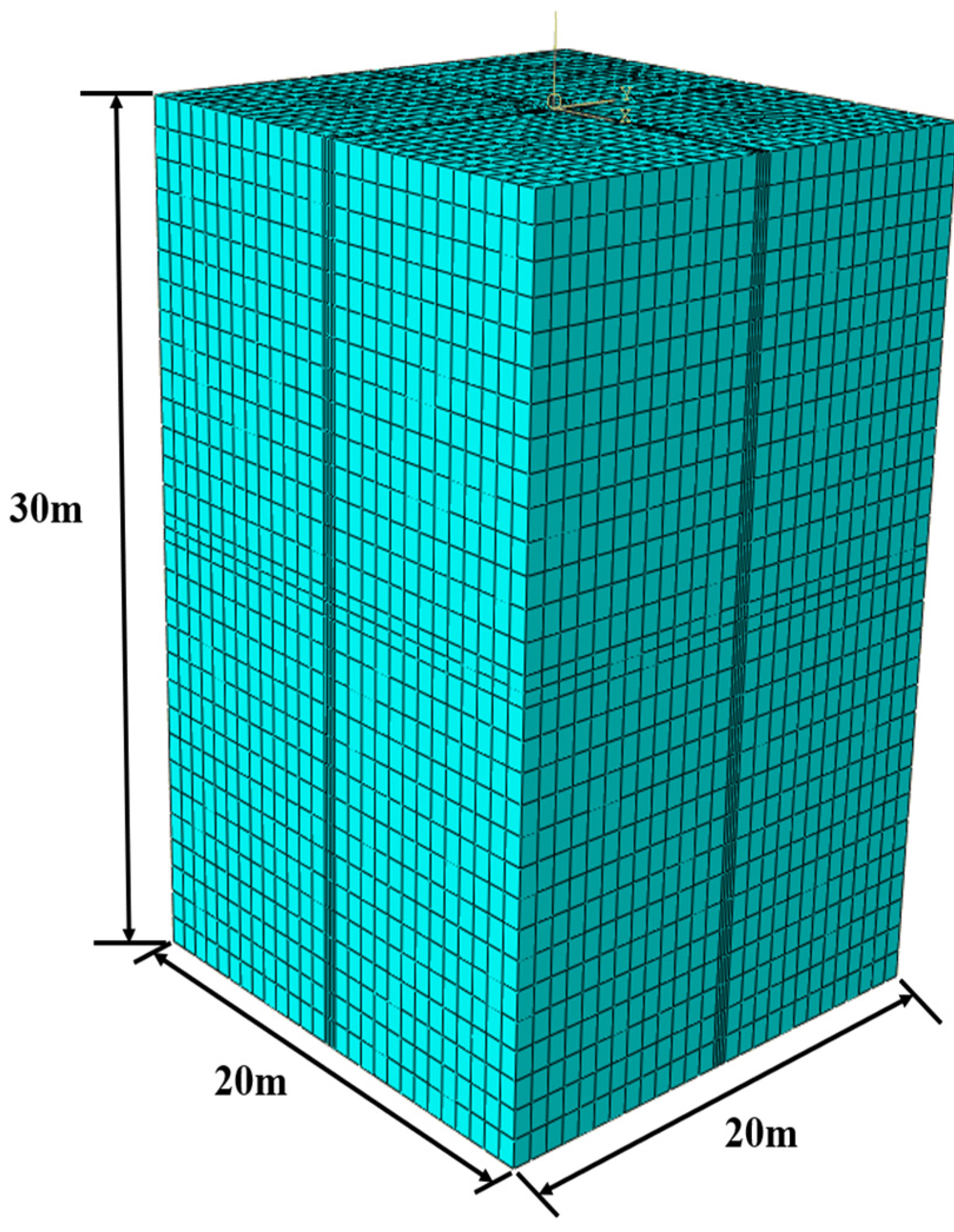
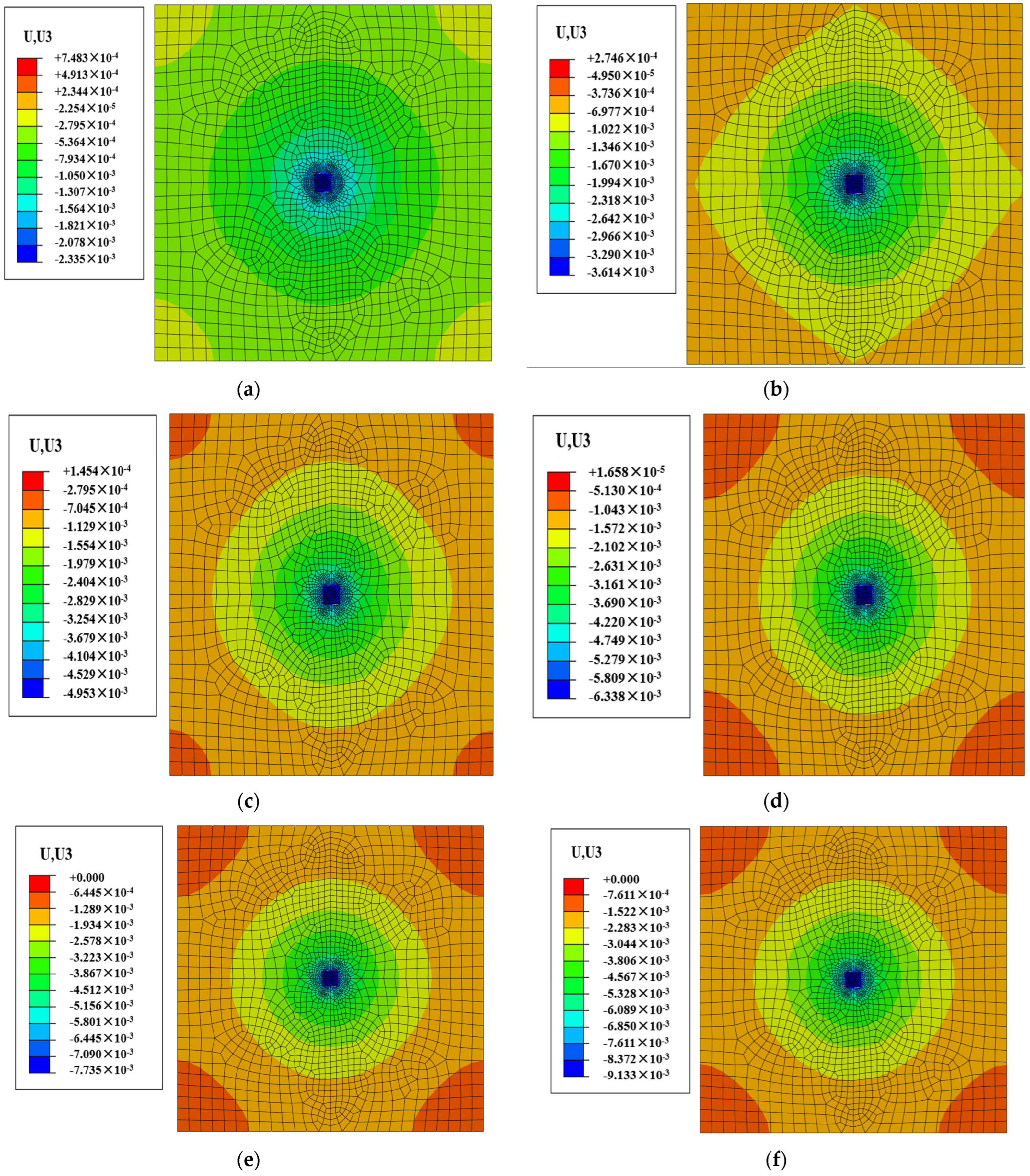
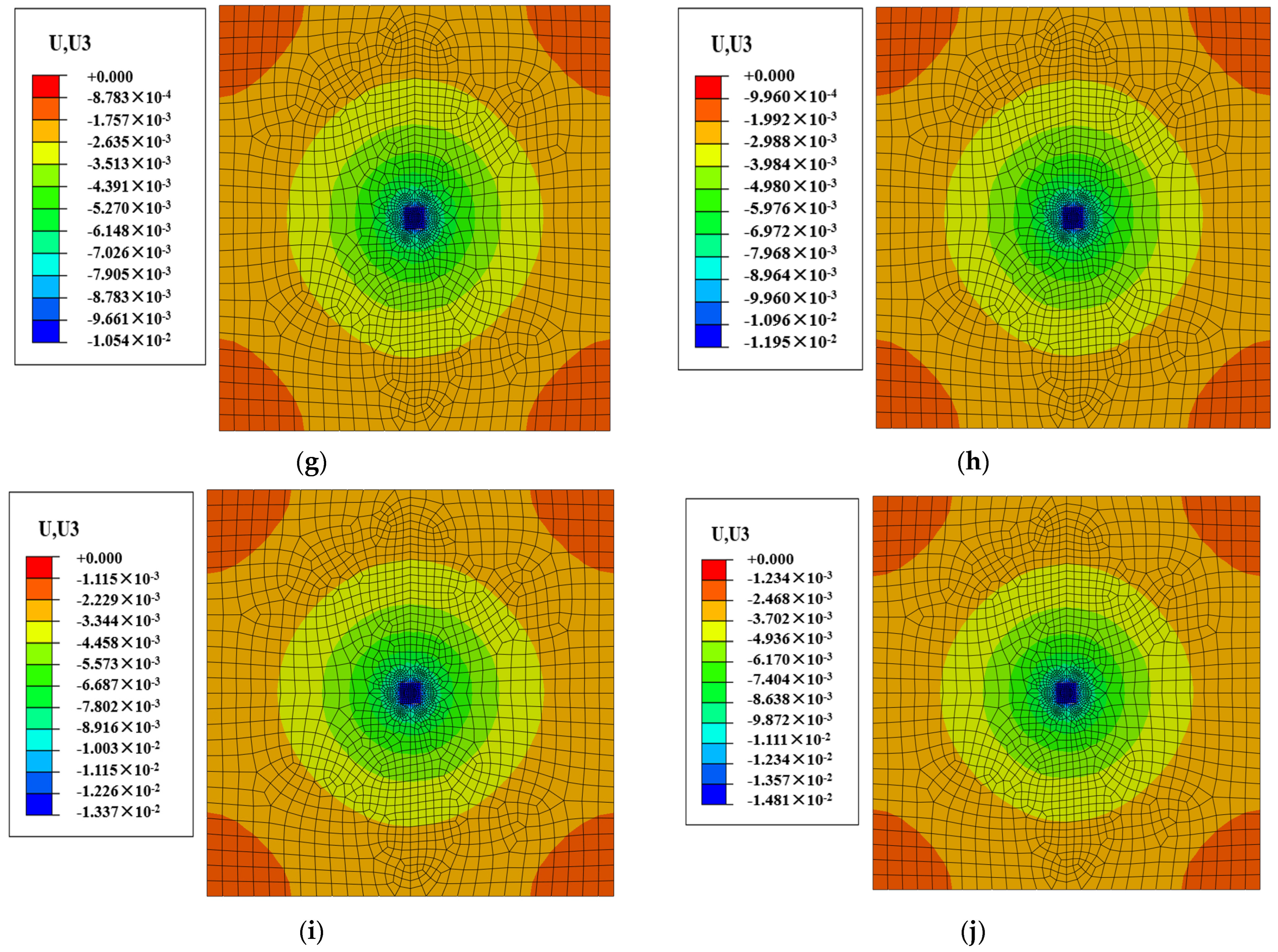
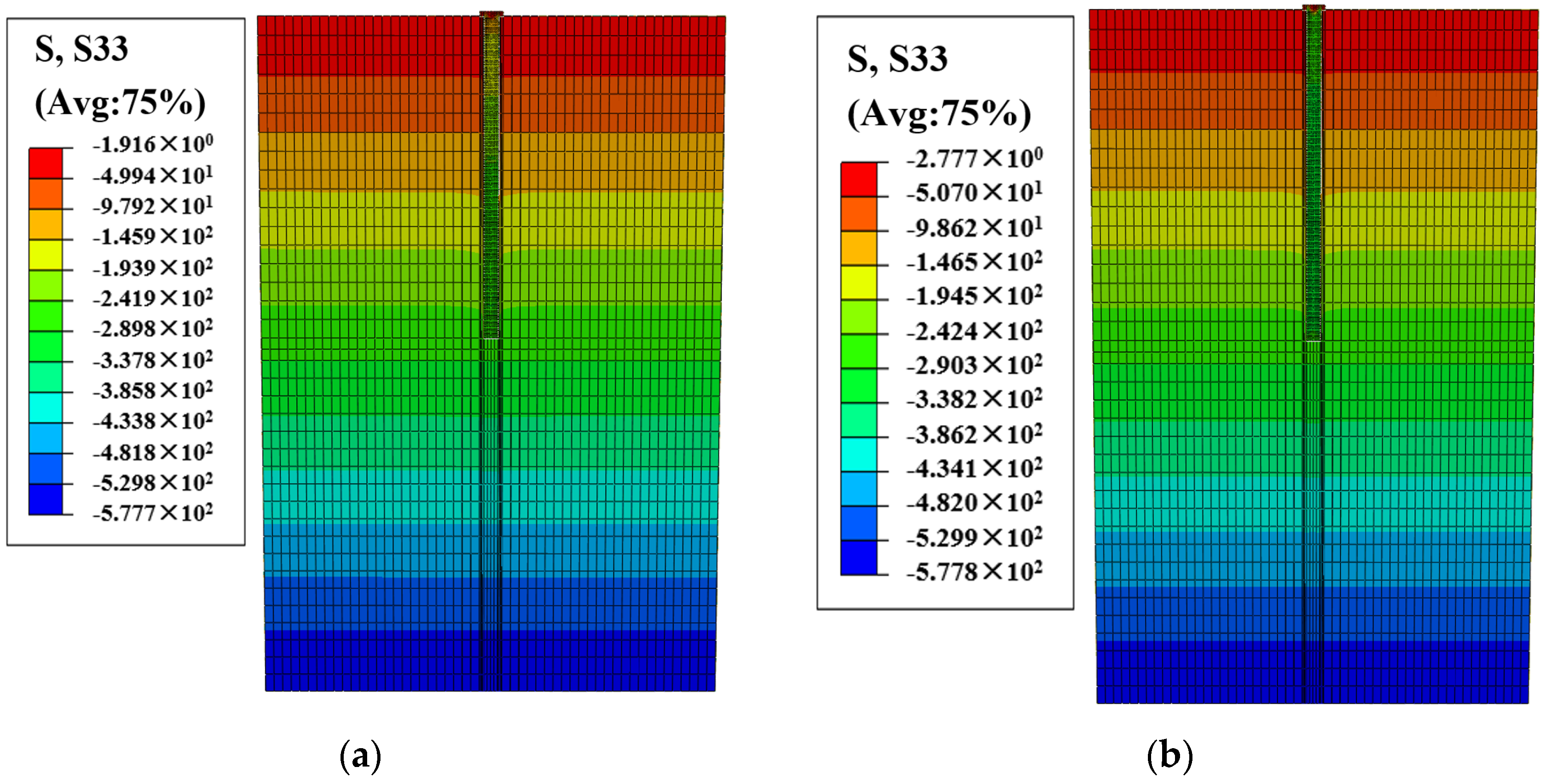
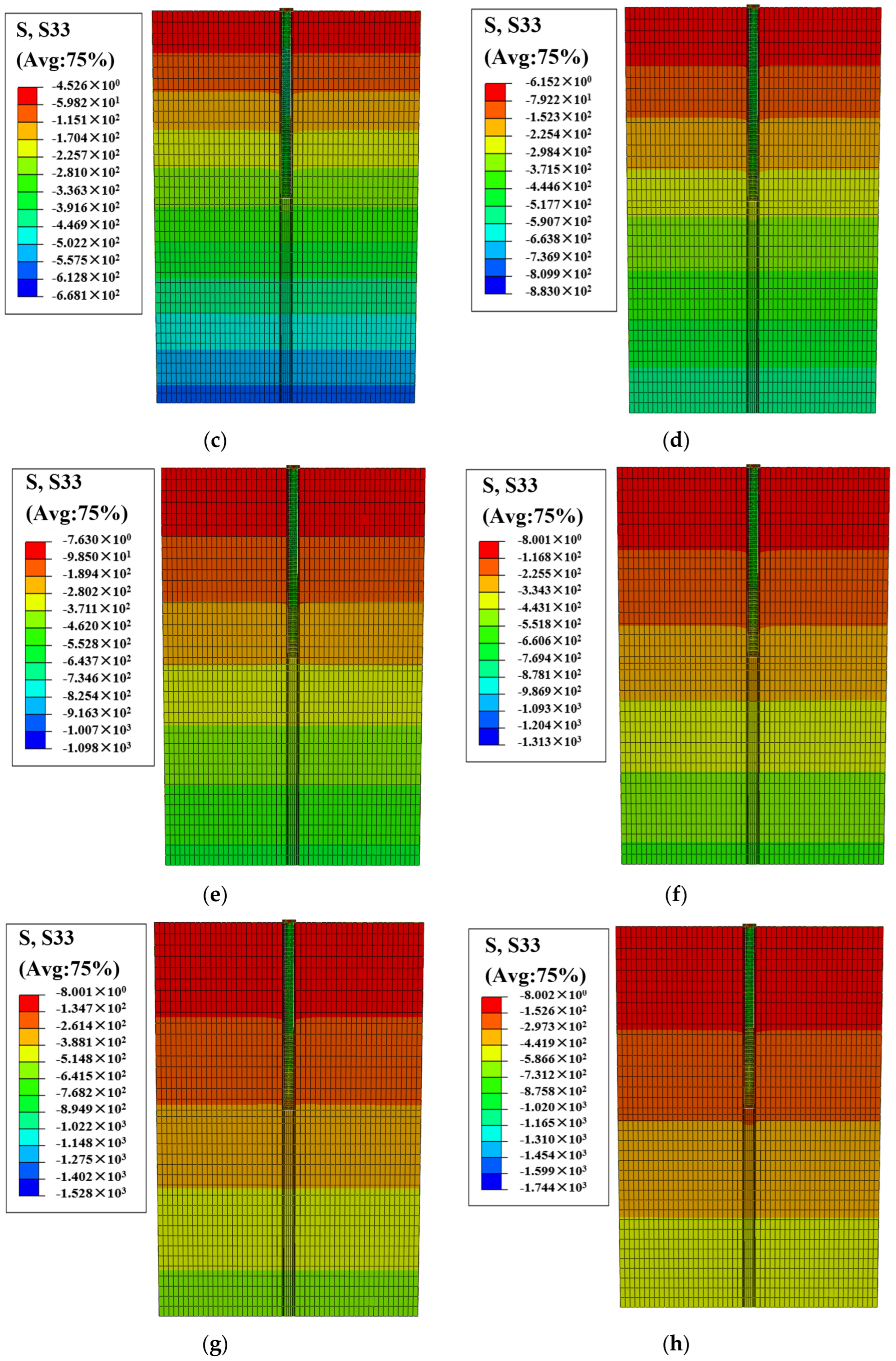
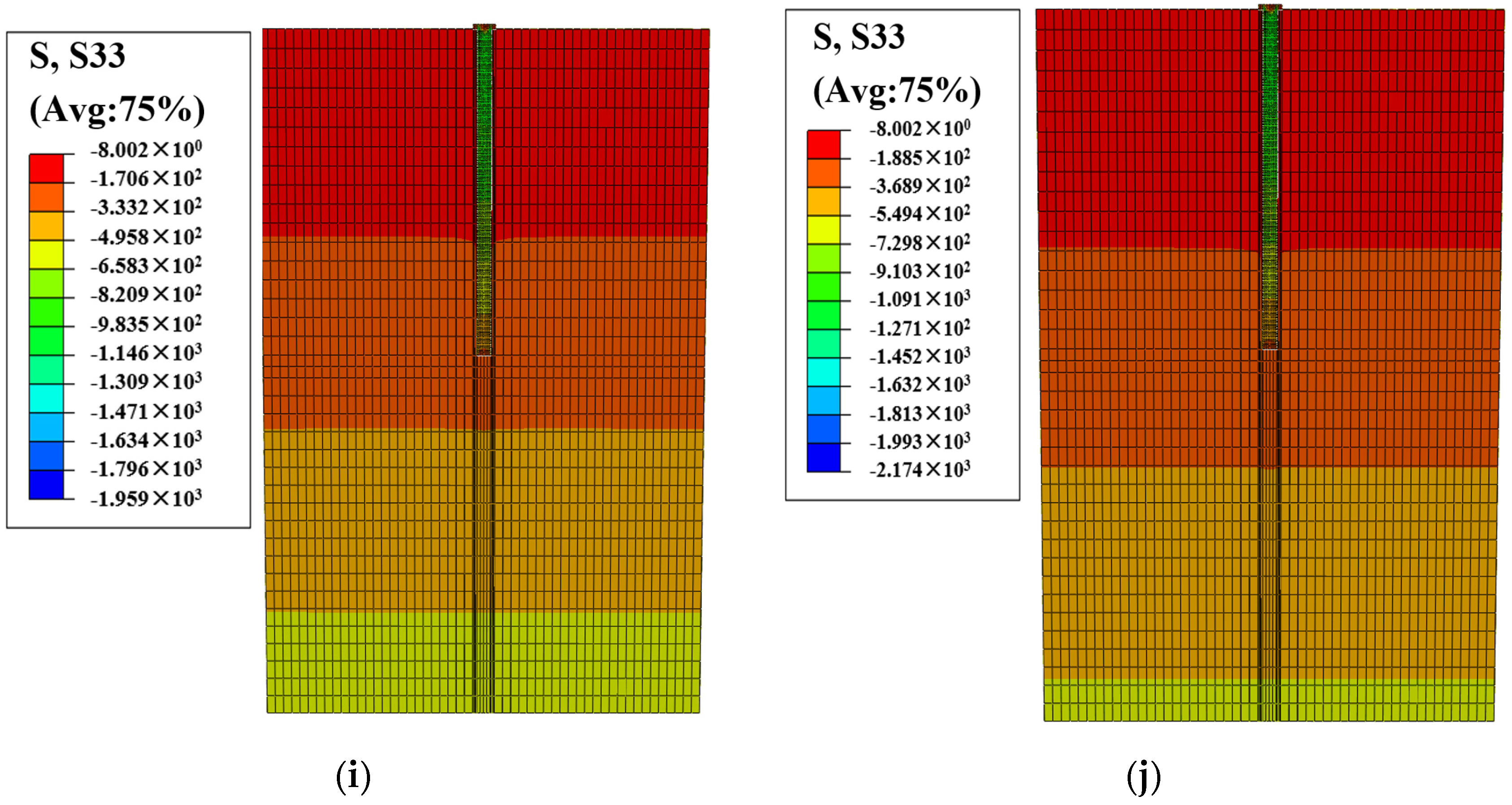


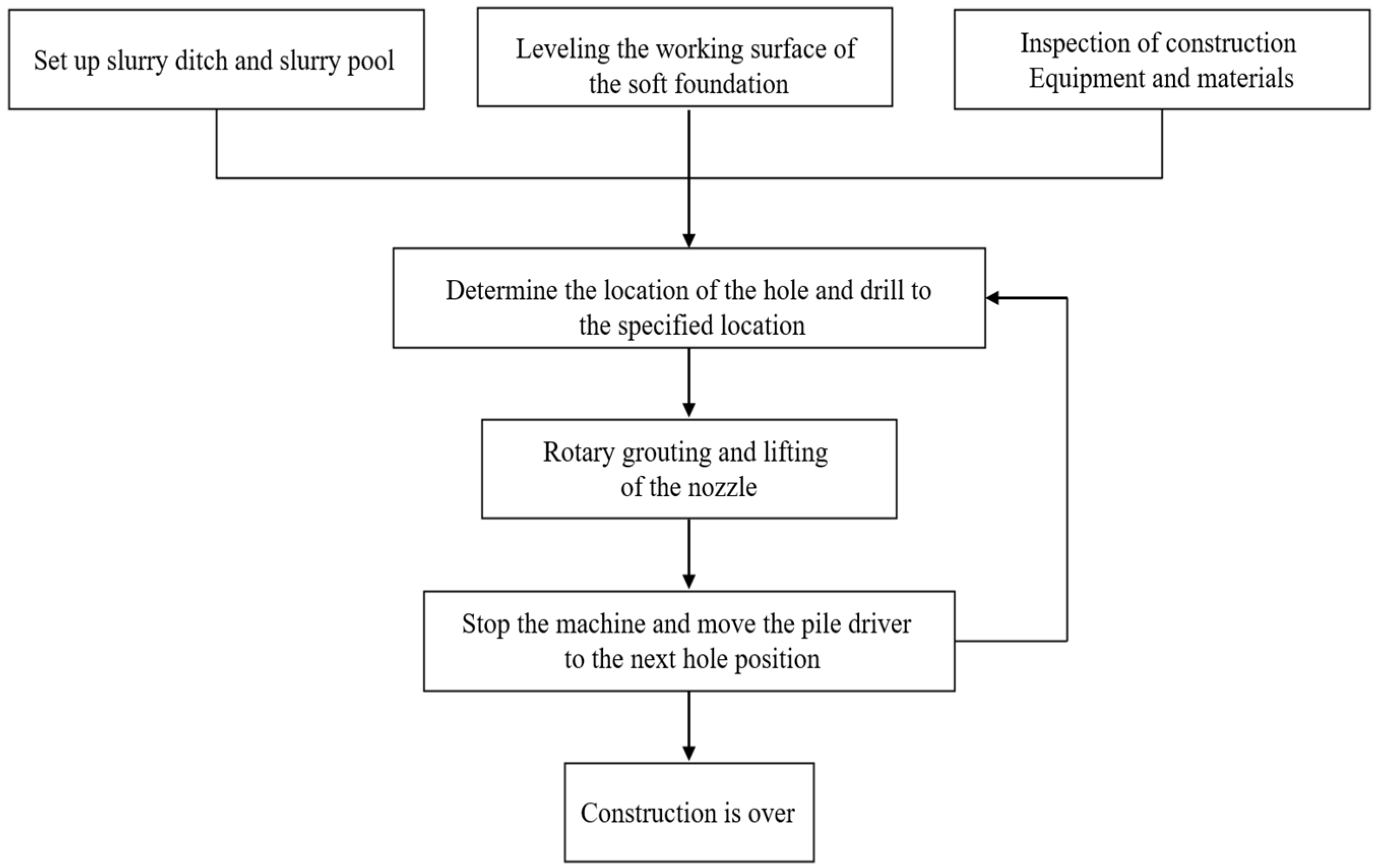
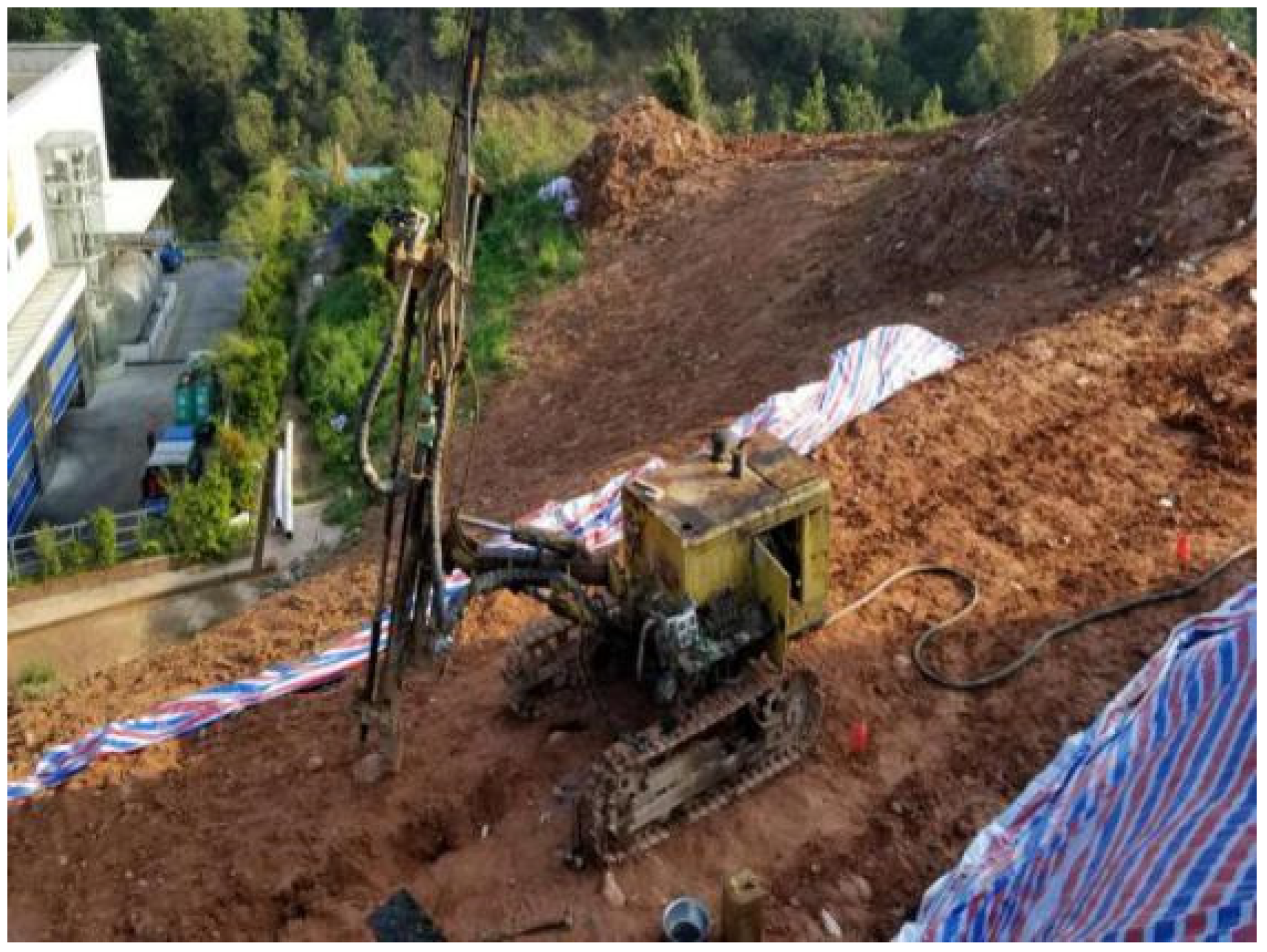

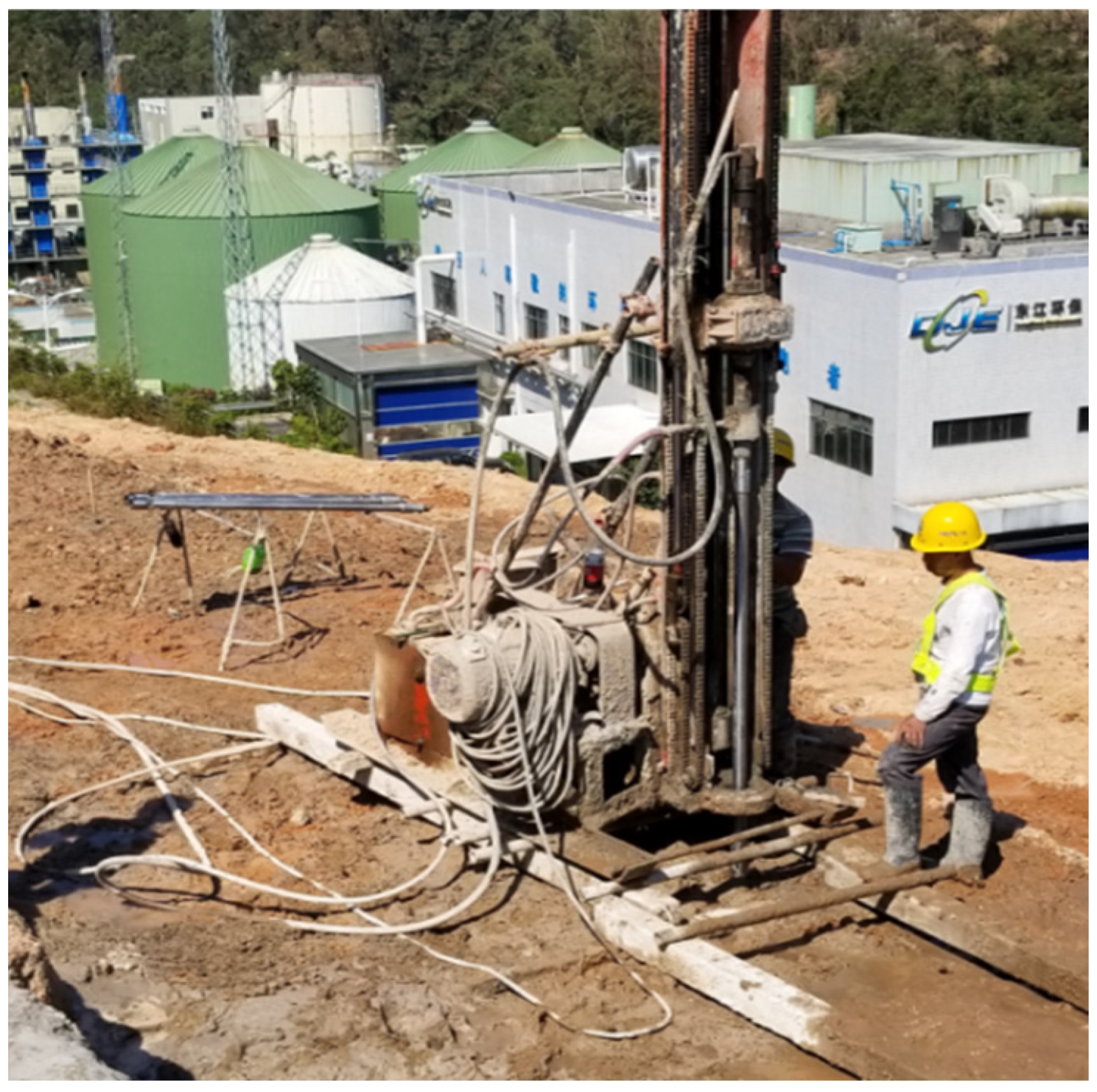
| Group Number | Station (Spacing of 1.2 m) | Station (Spacing of 1.0 m) | Cement Content (kg/m) | Water–Cement Ratio | Lift Speed (cm/min) | Slurry Pressure (MPa) | Air Pressure (MPa) |
|---|---|---|---|---|---|---|---|
| 1 | 1# | 10# | 250 | 1:1 | 0.10 | 20~30 | 0.70 |
| 2# | 11# | 0.15 | 0.75 | ||||
| 3# | 12# | 0.20 | 0.80 | ||||
| 2 | 4# | 13# | 275 | 1:1 | 0.10 | 20~30 | 0.70 |
| 5# | 14# | 0.15 | 0.75 | ||||
| 6# | 15# | 0.20 | 0.80 | ||||
| 3 | 7# | 16# | 300 | 1:1 | 0.10 | 20~30 | 0.70 |
| 8# | 17# | 0.15 | 0.75 | ||||
| 9# | 18# | 0.20 | 0.80 |
| Group Number | Station | Cement Content (kg/m) | Water–Cement Ratio | Lift Speed (cm/min) | Slurry Pressure (MPa) | Air Pressure (MPa) |
|---|---|---|---|---|---|---|
| 1 | 1# | 266 | 1:1 | 0.12 | 20 | 0.70 |
| 2# | 255 | 0.16 | 21 | 0.75 | ||
| 3# | 248 | 0.23 | 22 | 0.80 | ||
| 10# | 264 | 0.11 | 20 | 0.70 | ||
| 11# | 256 | 0.16 | 21 | 0.75 | ||
| 12# | 250 | 0.22 | 22 | 0.80 | ||
| 2 | 4# | 282 | 1:1 | 0.12 | 23 | 0.70 |
| 5# | 279 | 0.22 | 24 | 0.80 | ||
| 6# | 274 | 0.15 | 25 | 0.75 | ||
| 13# | 279 | 0.11 | 23 | 0.70 | ||
| 14# | 277 | 0.21 | 24 | 0.80 | ||
| 15# | 275 | 0.17 | 25 | 0.75 | ||
| 3 | 7# | 314 | 1:1 | 0.12 | 26 | 0.70 |
| 8# | 299 | 0.14 | 28 | 0.75 | ||
| 9# | 307 | 0.22 | 27 | 0.80 | ||
| 16# | 313 | 0.12 | 26 | 0.70 | ||
| 17# | 298 | 0.14 | 28 | 0.75 | ||
| 18# | 305 | 0.21 | 27 | 0.80 |
| Group Number | Station | Diameter of Jet-Grouting Pile (m) | The Degree of Pile Core Fragmentation | Cement Content (kg/m) | Are the Design Requirements Met? |
|---|---|---|---|---|---|
| 1 | 1# | 0.55 | - | 266 | no |
| 2# | 0.56 | - | 255 | no | |
| 3# | 0.57 | - | 248 | no | |
| 10# | 0.50 | - | 264 | no | |
| 11# | 0.56 | - | 256 | no | |
| 12# | 0.59 | - | 250 | no | |
| 2 | 4# | 0.60 | broken | 282 | no |
| 5# | 0.62 | - | 279 | no | |
| 6# | 0.60 | - | 274 | no | |
| 13# | 0.60 | broken | 279 | no | |
| 14# | 0.62 | - | 277 | no | |
| 15# | 0.65 | - | 275 | no | |
| 3 | 7# | 0.69 | - | 314 | yes |
| 8# | 0.66 | complete | 299 | yes | |
| 9# | 0.65 | - | 307 | yes | |
| 16# | 0.64 | - | 313 | yes | |
| 17# | 0.63 | complete | 298 | yes | |
| 18# | 0.60 | - | 305 | yes |
| Station | Maximum Test Load (kPa) | Eventual Settlement (mm) | Eigenvalues of Bearing Capacity (kPa) | Cement Content (kg/m) |
|---|---|---|---|---|
| 8# | 350 | 15.189 | 182.58 | 299 |
| 17# | 350 | 14.564 | 196.89 | 298 |
| Parameter | Cement Parameters (kg/m) | Water–Cement Ratio | Lift Speed (cm/min) | Spraying Pressure (MPa) | Air Pressure (MPa) | Rotary Spray Speed (r/min) |
|---|---|---|---|---|---|---|
| Index | 300 | 1:1 | 20 | 20~28 | 0.7 | 20 |
| Material Category | Modulus of Elasticity (MPa) | Poisson’s Ratio | Severe (kN·m−3) | Cohesion (kPa) | Internal Friction Angle (°) |
|---|---|---|---|---|---|
| Jet-grouting pile | 10,500 | 0.2 | 21.5 | - | - |
| Plain fill | 3.1 | 0.35 | 19.59 | 8 | 10 |
| Miscellaneous fill | 3.3 | 0.33 | 19.6 | 8 | 12 |
| Strongly weathered argillaceous siltstone | 10.2 | 0.15 | 20.2 | 30 | 28 |
| Increase in the number of piles | 1 | 2 | 3 | 4 | 5 | 6 |
| The amount of settlement of intermediate piles (mm) | 2.4509 | 2.7171 | 2.9445 | 3.1349 | 3.3279 | 3.3851 |
Disclaimer/Publisher’s Note: The statements, opinions and data contained in all publications are solely those of the individual author(s) and contributor(s) and not of MDPI and/or the editor(s). MDPI and/or the editor(s) disclaim responsibility for any injury to people or property resulting from any ideas, methods, instructions or products referred to in the content. |
© 2024 by the authors. Licensee MDPI, Basel, Switzerland. This article is an open access article distributed under the terms and conditions of the Creative Commons Attribution (CC BY) license (https://creativecommons.org/licenses/by/4.0/).
Share and Cite
Wang, T.; Liu, X.; Liu, L.; Xiong, W.; Li, Z. Research on the Reinforcement Effect and Bearing Characteristics of High-Pressure Jet-Grouting Piles on Covered Road Composite Ground in Landfill Sites. Buildings 2024, 14, 444. https://doi.org/10.3390/buildings14020444
Wang T, Liu X, Liu L, Xiong W, Li Z. Research on the Reinforcement Effect and Bearing Characteristics of High-Pressure Jet-Grouting Piles on Covered Road Composite Ground in Landfill Sites. Buildings. 2024; 14(2):444. https://doi.org/10.3390/buildings14020444
Chicago/Turabian StyleWang, Tao, Xu Liu, Liyuan Liu, Wang Xiong, and Zhenyun Li. 2024. "Research on the Reinforcement Effect and Bearing Characteristics of High-Pressure Jet-Grouting Piles on Covered Road Composite Ground in Landfill Sites" Buildings 14, no. 2: 444. https://doi.org/10.3390/buildings14020444
APA StyleWang, T., Liu, X., Liu, L., Xiong, W., & Li, Z. (2024). Research on the Reinforcement Effect and Bearing Characteristics of High-Pressure Jet-Grouting Piles on Covered Road Composite Ground in Landfill Sites. Buildings, 14(2), 444. https://doi.org/10.3390/buildings14020444






